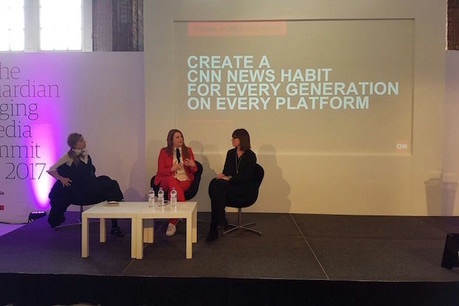
"In the early days of social media, people would be very comfortable sharing news and information with their 150 Facebook friends, but as their networks grew, they saw less value in mass social sharing," said Samantha Barry, head of social media and emerging media at CNN Worldwide, at the Guardian Changing Media Summit in London today (16 March).
Realising the trend in peer-to-peer sharing, CNN launched on three messaging apps in 2016: Line, Kik and Facebook Messenger.
"We had to change our metric of success in order to experiment with things like chatbots and messaging apps," she explained.
"When I started two and a half years ago, the only metric for success was the number of referrals generated and how many eyeballs you're sending to TV, but now we focus on creating a CNN news habit for every generation on every platform – reaching people we hadn't reached before and getting news to them in the ecosystems they live in."
Line
CNN launched on Line in March 2016, and is now the largest news brand on the platform with 4.7 million followers, the majority of which are in Asia.
"We are reaching customers we haven't reached before," she said, noting that CNN had to learn new ways of communicating with audiences in different ways.
"We launched our first sticker set of presenters and correspondents on Line – and our audience reacted massively to it."
We've launched a new a sticker set on LINE. Start sharing the news of your life 👍 https://t.co/aillySkiit pic.twitter.com/Oy7kOabau5
— CNN (@CNN) October 4, 2016
For the US election night, a CNN editor started a Line chat which saw half a million people at one time participating and asking questions.
Facebook Messenger
Using Facebook Messenger, CNN has covered debates and world events live, and each morning sends out five stories to readers.
CNN was one of the first news organisations to adopt Facebook Messenger's bot platform in April 2016, with the aim of reaching a global audience and connect in a more personalised way, but at scale.
"It is still not as advanced as people would like it to be at this stage – it is hard to have a conversation with CNN, but it is the first step for us into innovating how we communicate with our audience in this intimate messaging space," she said.
Editors gather CNN stories from around the world and publish them according to the time of day and the type of audience they are trying to reach, with people being able to choose the type of stories they'd like to read about.
Kik
"Kik, for me, has been a revelation in how we talk to young people in the US," Barry said.
During the Rio Olympics, CNN developed two 'choose your own adventure' experiences, taking people to Copacabana beach, where they could ask passers-by questions or choose to keep walking – a creative way of telling a story and one that appealed to readers wanting to influence what they saw.
Barry noted they found the 13 to 17-year-old audience on Kik to be just as into politics and current affairs as someone watching CNN's Anderson Cooper in the evening, having reported on the recent US election using the app.
"My favourite thing with Kik is the two GIF trays, an emoji and a sticker set we had made for the election.
"We had to tell the audience, using their language of stickers and emojis, the story of the 2016 election.
"It was interesting because it was the first time a news organisation like CNN could ever, at that stage, try to tell a story using those storytelling tools – it was a fascinating learning curve for us."
Free daily newsletter
If you like our news and feature articles, you can sign up to receive our free daily (Mon-Fri) email newsletter (mobile friendly).
Related articles
- How NRK uses AI-generated summaries to boost younger readers’ engagement
- Trust is not a "useless metric" - we just need to understand it better
- New playbook to help publishers boost content strategy
- Thinking outside the [chat]box
- How Ruben Reuter challenges disability prejudice in the media industry









